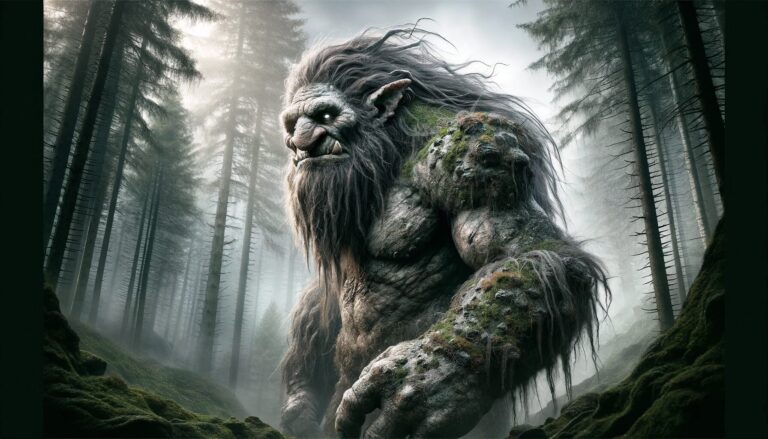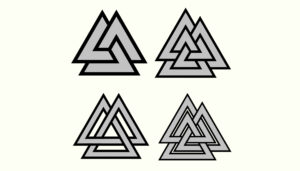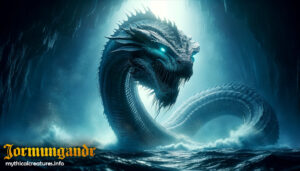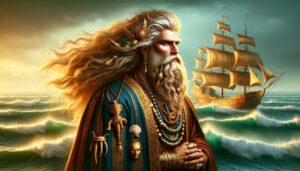Table of Contents
In the shadowy realms of folklore and legend, troll emerge as formidable and enigmatic figure, epitomizing the essence of otherworldly being. These captivating creatures have enthralled the imagination of countless generations, seamlessly weaving their way into the narratives of diverse cultures. Each culture, in turn, imparts its distinctive interpretation to the troll mythology.
Origins
Trolls find their origins in Norse mythology, where they were initially portrayed as malevolent beings. In Norse mythology, they associated trolls with the untamed wilderness, lurking in remote forests, mountains, and caves. People feared and intrigued trolls alike for their cunning and strength.
Family Ties
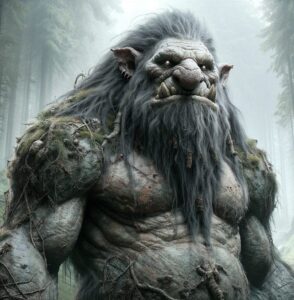
In Norse mythology, trolls portrayed a diverse group, comprising various entities with their distinct characteristics, rather than being confined to a single family. One of the most famous troll families is the Jotnar, a race of giants often referred to as trolls due to their close association with these enigmatic beings. The Jotnar encompassed a wide range of individuals, from those who were benevolent and wise to those who were malevolent and destructive.
Physical Appearance
The physical appearance of trolls has varied across different cultures and interpretations. In Norse mythology, trolls were often depicted as large and grotesque creatures with hulking bodies, warty skin, and exaggerated facial features. In contrast, Scandinavian folklore introduced the idea of smaller, more human-like trolls, often living in secluded areas. These variations, however, reflect the rich diversity of troll folklore, with some resembling giants and others resembling misshapen humans.
Abilities
Trolls possess extraordinary abilities, often including immense physical strength and resilience. In some tales, they have the power to control natural elements such as rocks and trees, allowing them to create obstacles or change the landscape to their advantage. Trolls are also known for their regenerative abilities, making them nearly invulnerable in battle. These supernatural qualities only add to the aura of mystery surrounding these creatures.
Symbols
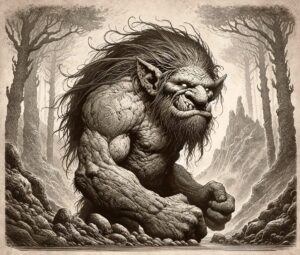
Trolls seldom take symbolic form since they predominantly exist within narratives rather than visual art. Nevertheless, their connection to the wilderness, darkness, and concealed realms associates them symbolically with the enigmatic and fearsome facets of the natural world. In this regard, trolls symbolize the untamed wilderness that humanity has historically both admired and dreaded.
Interactions with Humans
Trolls in folklore and mythology often interact with humans in intriguing ways. These interactions range from menacing encounters to moments of unexpected assistance. Moreover, in some stories, trolls are portrayed as dangerous adversaries who pose a threat to travelers and villages. They may demand tolls or riddles, and those who fail to appease them can face dire consequences.
On the other hand, there are tales where trolls demonstrate a more complex relationship with humans. Some stories depict trolls as enigmatic beings who test the wit and courage of individuals. In such narratives, clever humans can outsmart trolls, earning their respect or even assistance.
Myths and Stories
- The Legend of Three Billy Goats Gruff: One of the most famous troll stories hails from Norwegian folklore and is known as “The Legend of Three Billy Goats Gruff.” In this tale, three clever goats attempt to cross a bridge guarded by a fearsome troll who threatens to eat them. However, through wit and cunning, the goats outsmart the troll and safely cross the bridge. This story serves as a cautionary tale, highlighting the perils of arrogance and emphasizing the triumph of cleverness over brute force.
- The Story of Skogsrå: In Swedish folklore, the Skogsrå is a female troll-like creature who resides in the forest. She is known for her bewitching beauty, which conceals her hollow back, often likened to the rotting trunk of a tree. The Skogsrå lures unsuspecting travelers into the forest, where they become lost and disoriented. This story reflects the dual nature of the wilderness, both alluring and dangerous.
Symbolic Interpretations
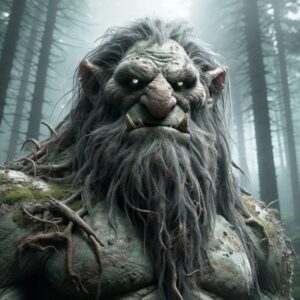
Trolls, with their diverse characteristics and mythical attributes, can be interpreted in various symbolic ways. They represent the untamed aspects of nature and the wild, reminding us of the unknown and unexplored territories of our world. Trolls also embody the idea of hidden threats and challenges that we may encounter in life, emphasizing the importance of wit and wisdom over brute strength.
Cultural Impact
Trolls have left an indelible mark on popular culture, transcending their origins in Norse mythology. Furthermore, they have been prominently featured in literature, art, and cinema, often assuming roles as antagonists or mysterious creatures that test the hero’s resolve. Notable examples include J.R.R. Tolkien’s trolls in “The Hobbit” and the trolls in Disney’s “Frozen.” These instances showcase the enduring fascination with these mythical beings.
Thematic Exploration
The troll archetype in folklore and mythology delves into themes of duality and the primal aspects of humanity. Moreover, trolls symbolize the darker side of nature, where beauty can conceal danger, and the untamed forces of the world can become a threat to the unprepared. Consequently, these enduring themes continue to resonate with audiences, serving as a poignant reminder of the intricate and multifaceted relationship between humanity and the natural world.
Similarities
Several creatures from folklore and mythology share similarities with trolls in various ways. Here are a few examples:
Ogres, often depicted as large, menacing beings with an appetite for human flesh, frequently inhabit remote areas and possess formidable physical strength.
Giants, akin to trolls, are commonly portrayed as colossal, powerful creatures with deep ties to the natural world. In certain cultures, “giant” and “troll” are interchangeable terms.
Goblins: Goblins are typically smaller than trolls but share a reputation for mischief and malevolence. They dwell in hidden places and can be antagonistic toward humans.
Kobolds, famed for their mischievous and occasionally malevolent tendencies, frequently establish associations with caves, mines, and various underground settings.
In Japanese folklore, oni resemble ogre-like entities known for their strength, often depicted with horns and unruly hair. They can assume both menacing and protective roles.
Gnomes: Gnomes are smaller, earth-dwelling creatures, often portrayed as guardians of nature. While less threatening than trolls, they share a connection to the natural world.
Dwarves: Much like trolls, dwarves frequently associate themselves with mountains and underground domains. They exhibit exceptional craftsmanship skills and can also assume the roles of formidable warriors.
Cyclopes: In Greek mythology, cyclopes are giant, one-eyed beings known for their strength. They can be seen as parallels to trolls in some contexts.
Modern culture
Trolls have found their way into modern culture through various movies, books, and other forms of media. They continue to be popular and intriguing characters that captivate audiences. Here are some examples of where you can find trolls in modern culture:
Movies
Frozen (2013): In Disney’s animated blockbuster “Frozen,” trolls play a significant role in the story. These trolls are depicted as magical rock creatures with the ability to heal and manipulate memories. They help Anna and Kristoff on their journey, providing both comic relief and wisdom.
The Hobbit Trilogy (2012-2014): J.R.R. Tolkien’s trolls make an appearance in the film adaptation of “The Hobbit.” Bilbo Baggins and a group of dwarves encounter three dim-witted trolls early in their quest. This encounter adds a touch of humor and adventure to the story.
Trolls (2016): “Trolls” is an animated musical film featuring colorful, lovable trolls. These trolls are known for their vibrant hair and infectious happiness. The movie explores themes of joy and the importance of embracing one’s true self.
Books
In the world of Harry Potter, trolls make several appearances throughout the series. In “Harry Potter and the Philosopher’s Stone” (or “Harry Potter and the Sorcerer’s Stone” in the U.S.), Harry and his friends encounter a troll, marking one of their earliest encounters with magical creatures.
Terry Pratchett’s Discworld series includes a variety of trolls, among them Detritus, a character made of silicon rather than traditional rock. The series humorously delves into the lives and interactions of these fantasy creatures.
André Øvredal’s book, “The Troll Hunters” (Trolljegeren), which served as the inspiration for the 2010 Norwegian found-footage film “Trollhunter,” follows a group of students investigating mysterious bear killings in Norway. Their investigation leads them to a hidden world of trolls, concealed from the public eye.
Video Games
The Elder Scrolls Series: In the popular video game series “The Elder Scrolls,” trolls are common enemies that players encounter in various regions. They are known for their brutish strength and regenerative abilities.
World of Warcraft: Trolls are a prominent race in the massive multiplayer online role-playing game “World of Warcraft.” Players can choose to play as trolls or encounter them as adversaries in the game’s expansive world.
FAQ
Where do trolls originate from?
Trolls originate primarily from Norse mythology but appear in various cultures' folklore.
What do trolls look like?
Trolls' appearance varies but can include large, grotesque forms or smaller, more human-like figures.
Do trolls have special abilities?
Yes, trolls are known for their strength, regenerative abilities, and sometimes control over natural elements.
How do trolls interact with humans?
Troll interactions range from menacing threats to moments of clever human outwitting.
What do trolls symbolize?
Trolls symbolize the untamed and potentially perilous aspects of the natural world.
What are some similar creatures to trolls?
Similar creatures include ogres, giants, goblins, and oni, depending on the cultural context.
